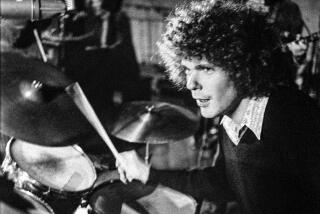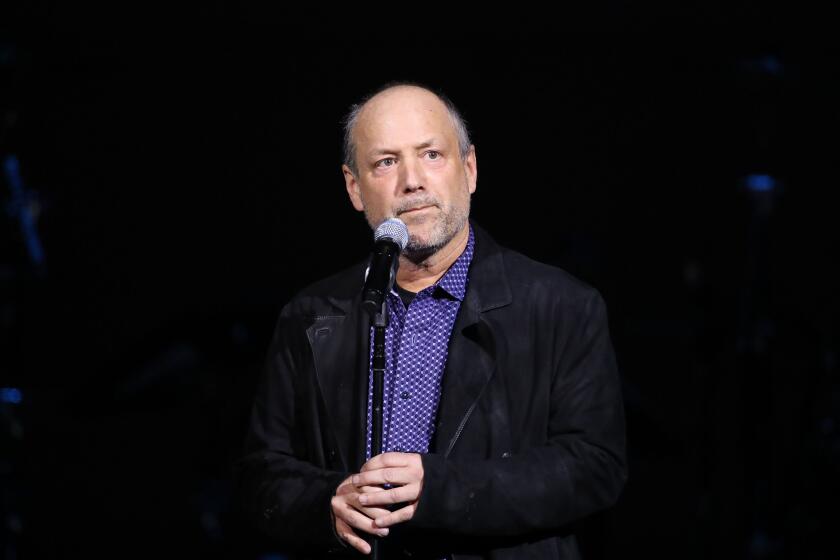Composer was a synthesizer pioneer
- Share via
As an arranger and conductor in the 1960s, Mort Garson worked on albums by artists such as Mel Torme, Joanie Sommers and Glenn Yarbrough.
As a composer, he wrote music for Mel Brooks’ and Carl Reiner’s 1975 animated television special “The 2000 Year Old Man,” “The Untamed World” documentary series, game shows, movies and “Marilyn! the Musical,” which debuted in London in 1983.
And teamed with lyricist Bob Hilliard, he co-wrote the 1963 Ruby and the Romantics hit “Our Day Will Come,” which rose to No. 1 on national charts.
But it was his work as a composer using the then-new Moog synthesizer on a series of albums in the late 1960s and ‘70s that developed a cult following that continues today.
Garson died of renal failure Jan. 4 in a hospital in San Francisco, said his daughter, Day Darmet. He was 83.
“He gained his greatest underground loyal fans for all of his electronic creativity,” Darmet said. “If you go on EBay, people are still trying to buy those albums.”
Beginning with “The Zodiac: Cosmic Sounds” in 1967, Garson created numerous albums using the Moog synthesizer, including “Electronic Hair Pieces,” a 1969 version of songs from the hit Broadway musical “Hair,” and “Signs of the Zodiac,” a 12-volume 1969 series featuring one album for each astrological sign.
Garson was making “The Zodiac: Cosmic Sounds” album for Elektra with writer Jacques Wilson when an orchestra member said he knew engineer Robert Moog, who had invented the first commercially available electronic music synthesizer a few years earlier.
“I met him, got interested in his invention and immediately put it in ‘Zodiac’ to add a sweetness to the sound,” Garson told the Los Angeles Times in 1969.
“That was the first album ever to use the Moog synthesizer and a live orchestra together,” said Bernie Krause, who was at the “Zodiac” recording session.
Krause said he and his music partner, Paul Beaver, had introduced the Moog synthesizer to pop music and film in Hollywood in 1967 and were selling the units and teaching classes on how to use them.
“ ‘Zodiac’ is a very influential cult album from the ‘60s,” said Trevor Pinch, co-author of “Analog Days: The Invention and Impact of the Moog Synthesizer,” a 2002 book that featured a 1969 photograph of Garson and his Moog synthesizer on the cover.
“ ‘Zodiac’ influenced all sorts of people, including the Moody Blues,” Pinch said. “They came up with ‘Nights in White Satin’ after listening to ‘Zodiac: Cosmic Sounds.’ ”
Garson said in the Times interview that he didn’t use the Moog synthesizer in “a very sophisticated way” on the 1967 “Zodiac” album.
But by the time he and Wilson did the 1968 A&M; album “The Wozard of Iz: An Electronic Odyssey” -- a hippie-style parody of “The Wizard of Oz” in which Dorothy proclaims that “Kansas isn’t where it’s at” -- he said he had learned most of the techniques.
“His albums were fabulous examples of New Age music and really kind of kicked off the New Age genre -- and they were enormously popular,” Krause said. “It was part of the texture of the whole San Francisco flower scene and all the rest of it in the late ‘60s.”
At the time of Garson’s interview with The Times in July 1969, his Moog synthesizer music was about to be heard by millions of Americans who would be glued to their TV sets watching history in the making: the Apollo 11 mission to land on the moon.
At frequent intervals during coverage of the mission, CBS aired a 6 1/2 -minute commentary-free film produced by Chuck Braverman with music by Garson.
Garson completed the score for the film -- a doctored and edited version of NASA films from previous space flights -- in a week in the small studio in his home in the Hollywood Hills.
“The only sounds that go along with space travel are electronic ones,” he told The Times. “The Apollo film shows different facets of the flight -- blastoff, separation of the stages of the rocket, scenes of the moon at close range, of the astronauts playing games in the ship and of earthrise.”
The music, he said, “has to carry the film along. It has to echo the sound of the blastoff and even the static you hear on the astronauts’ report from space. People are used to hearing things from outer space, not just seeing them.
“So I used a big, symphonic sound for the blastoff, some jazzy things for the zero-G game of catch, psychedelic music for a section that uses negatives and diffuse colors on shots taken inside the ship, and a pretty melody for the moon. After all, it’s still a lovely moon.”
Born July 20, 1924, in Saint John, New Brunswick, Canada, Garson attended the Juilliard School of Music and was a pianist and arranger with dance orchestras before serving in Special Services during World War II.
He most recently composed a suite of music about San Francisco, his home since 1993.
“He was just putting the finishing touches on it,” Darmet said. “We were going to digitally record it; we still will.”
In addition to his daughter, he is survived by a grandson.
A graveside service will be held at 11 a.m. Saturday at Forest Lawn Memorial-Park, 6300 Forest Lawn Drive, Los Angeles.
--
More to Read
The biggest entertainment stories
Get our big stories about Hollywood, film, television, music, arts, culture and more right in your inbox as soon as they publish.
You may occasionally receive promotional content from the Los Angeles Times.










